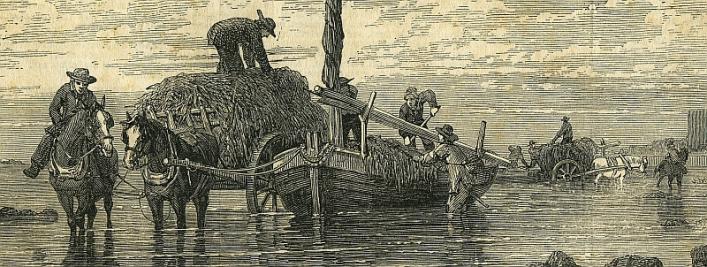The generosity of the Seigneur of Sark, Peter Le Pelley, from one of the two books about the island written by his great friend, the Reverend J L V Cachemaille, for many years the vicar of Sark. In 1860, the diary of the former 17th-century Sark minister, Elie Brėvint, was found in a loft in Sark. Cachemaille was inspired by this to investigate the archives of the Seigneurie and to write a series of articles based upon what he found, which were translated by Louisa Harvey and published in the Guernsey Magazine. From this was published the Descriptive Sketch, published by Frederick Clarke, and then republished in 1928. See Ewen & De Carteret, The Fief of Sark, The Guernsey Press, 1969. The illustrations are from the Library Collection, the drawing showing the Seigneurie in Sark in Le Pelley's time.
In 1885 was published the original French text of the Ecclesiastical Discipline for Guernsey, edited by the Reverend G.-E. Lee of the Town Church and published by Thomas Bichard of the Bordage. The Police et discipline ecclesiastique was a set of regulations for the management of the Church and its congregation in the island, established by consensus in 1576 and which, despite the severity of its rules, remained in force until the Restoration in 1660, when Charles II imposed a form of Anglicanism on the island.
From Redstone's Royal Guide to Guernsey, written by Louisa Lane Clarke, who produced a new edition in 1856 following Queen Victoria's visit to Guernsey. A rather rosy description of vraicing—the gathering of wrack seaweed—which was in fact a highly competitive scramble for a valuable and free commodity, much prized by the islanders.
From G R Sims' comic Dagonet's Visit to Sark.
A few amusing extracts from the Library collections.
A list of fish in Guernsey French and their relative presence in island waters, from 1815, p. 15. The Monthly Magazine folded before the list could be continued.
Written by Louisa Lane Clarke for Redstone's Guide to Guernsey, first published in 1841. A copy of this Guide was given to Queen Victoria when she visited the island, and it was retitled Redstones' Royal Guide. This extract is from the fifth edition, published in 1856.
We whose hands and seals are hereunto set, Commissioners, appointed by Your Majesty's Commission, bearing date the 16th day of May, in the ninth year of Your Majesty's reign, for inquiring in to the Criminal Laws in force in Your Majesty's Channel Islands and into the constitutions and powers of the Tribunals and Authorities charged with the execution of such laws, humbly certify to Your Majesty that, having completed our inquiry so far as the same related to the Island of Jersey, the result of which we have already laid before Your Majesty in our First Report, we forthwith proceeded, in further obedience to Your Majesty's gracious commands, to the Island of Guernsey.Second Report of the Commissioners appointed to inquire into The State of the Criminal Law in the Channel Islands: Guernsey: London, William Clowes and Son for Her Majesty's Stationery Office, 1848.
Major Herbert Garland (1880-1921) was an explosives expert and the author of a short romantic novel set in Guernsey entitled Diverse Affections; his life is much more interesting than his novel. The effects of the devastating techniques he pioneered in Arabia are still being felt today.
Some fascinating letters from a young Caroline Guille Le Marchant to her friends in Bath and London, from Edith Carey's Scrapbook, and some contemporary winter ladies costumes for Christmas, from two bound volumes of fashion-plates, entitled in French Figures. The plates are hand-coloured; some are from The Fashions of London and Paris, a monthly magazine that began publication in 1798, published by Richard Phillips.





